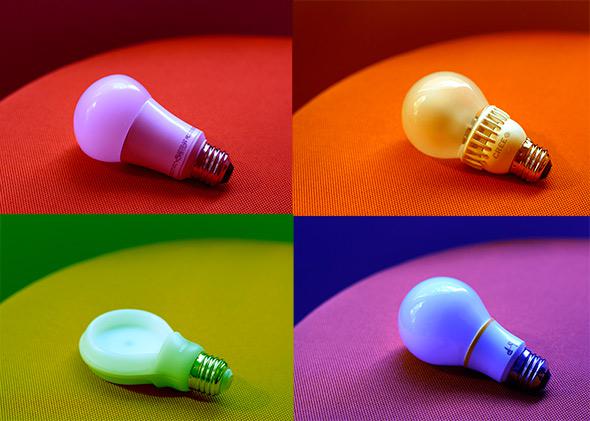As of Jan. 1 of this year, the 60-watt incandescent light bulb—that classic of the genre; the Edisonian ideal; the signifier that illuminates in your mind’s eye when you’re asked to picture “a light bulb”—was banned forever. Perhaps you prepped by hoarding a box of bulbs in the back of your closet. Or perhaps this news took you by surprise, and you now live in fear of the moment the beloved incandescent in your bedside lamp flickers out.
Either way, there will come a time when you’ll need to buy an alternative bulb. Don’t be scared. I’m here to help.
First of all, I must stipulate: You adore your incandescent bulbs. I get it. In 2008, Slate contributor Ron Rosenbaum penned a heartfelt ode to the “painterly glow” of incandescence. He argued that to ban incandescent bulbs was to “ban beauty.” He praised their “warm radiance” and “soft flare” and, in a bravura passage, worked in a reference to Nabokov and “the spirits of the dead inhabiting the tungsten filaments.” I love the passion! And the literary élan! (I’m sure there’s a decent Light in August pun to be made here but I can’t quite birth it.)
No doubt, Rosenbaum’s screed spoke for millions of incandescence-loving Americans. And you folks have a point: The aesthetics of incandescence are amazing. The unfortunate downside is that incandescent bulbs are awful energy hogs. Along with their lovely light they also emit a ton of useless heat, which wastes electricity.
New bulb technologies are waaaay more efficient. Like 80 percent more. That’s a big difference. Given that (according to lighting industry experts I spoke to) there are something like 4 billion screw-in light sockets in this country—the bulk of which remain occupied by leftover incandescent bulbs—the energy savings from a nationwide switch will add up.
At the time Rosenbaum was writing, the primary challenger to the incandescent bulb was the compact fluorescent, or CFL. CFLs are the size of a standard bulb but have spindly, spiraling fluorescent tubes in place of a filament. They blink to life with a depressing flicker and often take a few moments to achieve full brightness. They cast a wan, sickly light. In sum, they are unlovable. The outrage over the incandescence phase-out made sense when CFLs were the only alternative.
Luckily, better options have arrived. Bulbs using light emitting diodes (LEDs) illuminate instantly with no flicker. The quality of their light is, to my eyes, far warmer than you got from those dank CFLs. And LEDs are even more efficient, and last longer to boot. Yes, they’re pricier, but LEDs are vastly superior to CFLs in every other way.
But which LED bulb is best? I experimented with a few brands to see if I could suss out differences. To compare apples to apples, I tested only LED bulbs that aim to replicate the classic 60-watt/800 lumen incandescent bulb.
A little spec-splaining: Watts measure energy use, lumens measure brightness. A typical incandescent needs 60 watts to produce 800 lumens, for a lumens-to-watt ratio of 13.3. By contrast, most CFLs use only 14–15 watts to get to 800 lumens—for a much better lumens-to-watt ratio that’s up in the 50s. Even better are the LED bulbs I sampled: They emit 800 lumens but require just 9 or 10 watts to do it, for a lumens-to-watt ratio that’s way up around 80. Less juice, same brightness.
Prices on LED bulbs can vary widely from state to state, since there are different rebates available for meeting Energy Star efficiency guidelines. Most LED bulbs coming to market these days attempt to nail a basic price point around $10 for a single bulb, give or take a couple of dollars. That sounds expensive (incandescent bulbs were selling for 25 cents apiece before the ban), but LEDs make up the difference through energy cost savings and longevity: 1) You lop a few dollars off your electricity bill each year. 2) Incandescents had a lifespan of 1,000 hours, while LEDs last 25,000 hours. Most LEDs are rated to live around 23 years if you use them three hours per day. When you amortize 10 bucks over 23 years, the steeper price doesn’t seem like a huge deal.
But now we come to the elephant in the lamp socket: the quality of the light.
First, a quick aside on describing light. People enthuse about the “warm” glow of the incandescent bulb, but when we talk about color temperature we get it backward. Think of a flame coming off a log: The part close to the wood where the flame is hottest tends to be blue (which we think of as a “colder” color) while the end of the flame farther away from the log isn’t as hot temperature-wise but it will be orange or red (a “warmer” color). Candlelight has a color temperature of 1,850 kelvins. Standard 60-watt incandescents are 2,700 K. Some LED bulbs come close to matching this number, while others climb as high as 5,000 K or more—casting a bluer, “colder” light.
Ultimately, no matter what the numbers say, quality of light comes down to personal preference. You might want some reddish warmth in your bedroom for a romantic glow, while opting for a colder, harsher light in your kitchen or workspace. Your best bet is to visit a lighting store where you can observe how lit bulbs differ side by side—checking out how they illuminate your skin, or a piece of white paper. See what you like.
That said, here are one man’s findings, ordered from my least favorite to my top choice:
Insteon A19 LED Bulb
9 watts, 713 lumens
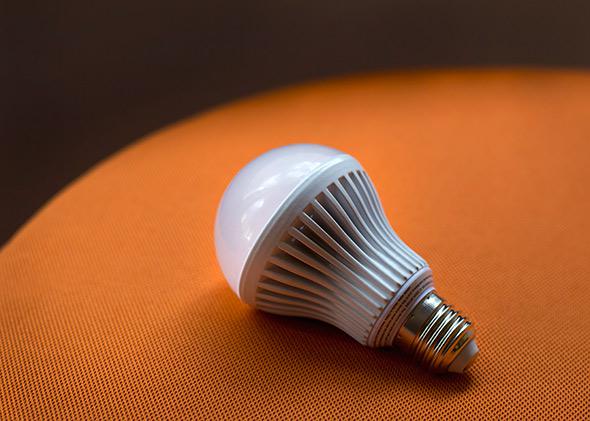
Photo by Juliana Jiménez Jaramillo
Insteon claims this bulb’s color temperature is comparable to an incandescent’s, but I found it threw off an almost greenish light. The pea soup hue repulsed me. The Insteon’s physical design—dominated by a big, crenelated podium at its base to disperse heat—leaves the illuminated part of the bulb as only a half globe, meaning it casts light in just one direction. (If the bulb is oriented upright in a lamp socket, light will rise up toward the ceiling and not down toward, say, the pages of the book you’re trying to read.) Insteon’s marketing push has more to do with the ancillary features made possible by LED technology, such as controlling the bulb remotely or hooking it into an automated home system. But bulb qua bulb, I found this entry lacking.
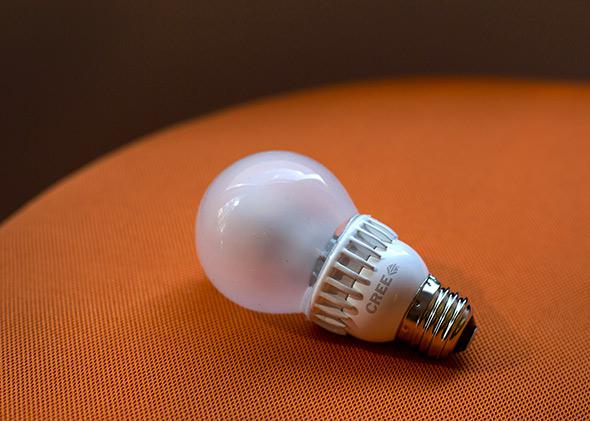
Photo by Juliana Jiménez Jaramillo
Cree Soft White LED 60-watt Replacement
9.5 watts, 800 lumens
The Cree wasn’t as greenish as the Insteon, but was still not my cup of tea, color-wise. Too harsh. It might be OK for your cubicle. Or, like, your abattoir. Just keep it out of your living space, where its cold light will instantly kill the mood.
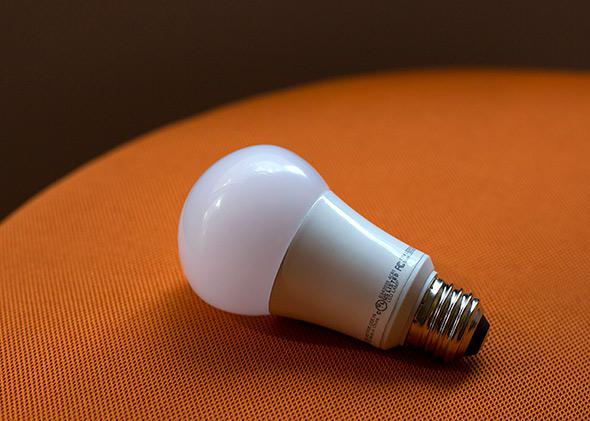
Photo by Juliana Jiménez Jaramillo
TCP Elite
10 watts, 800 lumens
This TCP bulb had the warmest, reddest tone of all the LEDs I tried. Its physical shape is attractive and functional. No complaints. A totally solid choice.
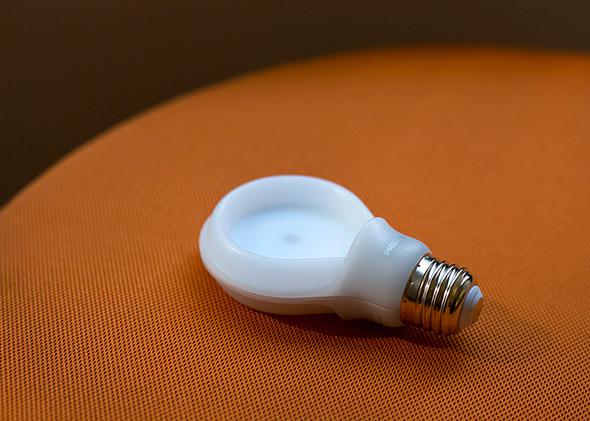
Photo by Juliana Jiménez Jaramillo
Philips SlimStyle
10.5 watts, 800 lumens
The SlimStyle has a radically different physical shape. Imagine if you could press a classic light bulb between the pages of a book to make it flatter. A bit like a Frisbee with a socket-fitting screw at its base. Made of tough plastic, the Philips felt almost impossible to break. I threw it across a room with no effect. It’s not as red and warm as the TCP, but its bright white light was clear, pleasing, and free of greenish undertones. Put this one in your kitchen, put the TCP in your living room, and call it a well-lit day.
But wait! There’s one more intriguing option coming soon. It’s not a CFL or an LED:
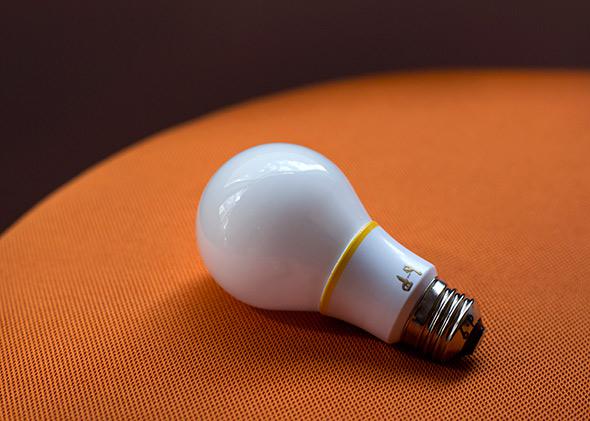
Photo by Juliana Jiménez Jaramillo
Finally Bulb
14.5 watts, 800 lumens
John Goscha is a 30-year-old who struck it rich a few years back with a dorm-room invention called IdeaPaint, which turns any wall into a whiteboard. Now he wants to conquer the wide open light bulb market. Goscha’s Finally bulb uses induction—a technology that traces its roots back to Nikola Tesla. (You can read about how it works here.) Using induction to produce light is nothing new, but in the past it tended to require an apparatus too large to fit inside a standard light bulb form. Goscha’s team, composed of lighting science veterans, says it has managed to shrink the induction unit down.
Though the Finally bulb is very energy efficient when compared to an incandescent, it’s a bit less efficient than an LED. At 14.5 watts, and a lumens-to-watt ratio of 55, it’s more in line with a CFL. It also contains traces of mercury, while LEDs don’t. (Which may or may not be important to you. A scientist on the Finally team answers questions about it here.)
Given these drawbacks, why am I bothering to mention the Finally bulb? Because its light quality is superb. Rosy pink. Toasty enough to warm even Ron Rosenbaum’s heart. To my untrained eyes, it’s nearly indistinguishable from an incandescent. When I set up two light fixtures side by side in the Slate office and asked people to compare the Finally to these LED bulbs, the Finally won every time. “It makes my skin look radiant,” enthused one colleague.
You won’t go wrong buying one of my recommended LED bulbs now. But the Finally bulb is scheduled to hit shelves this October. You might wait to see if your stock of precious incandescents can hold out until then.
